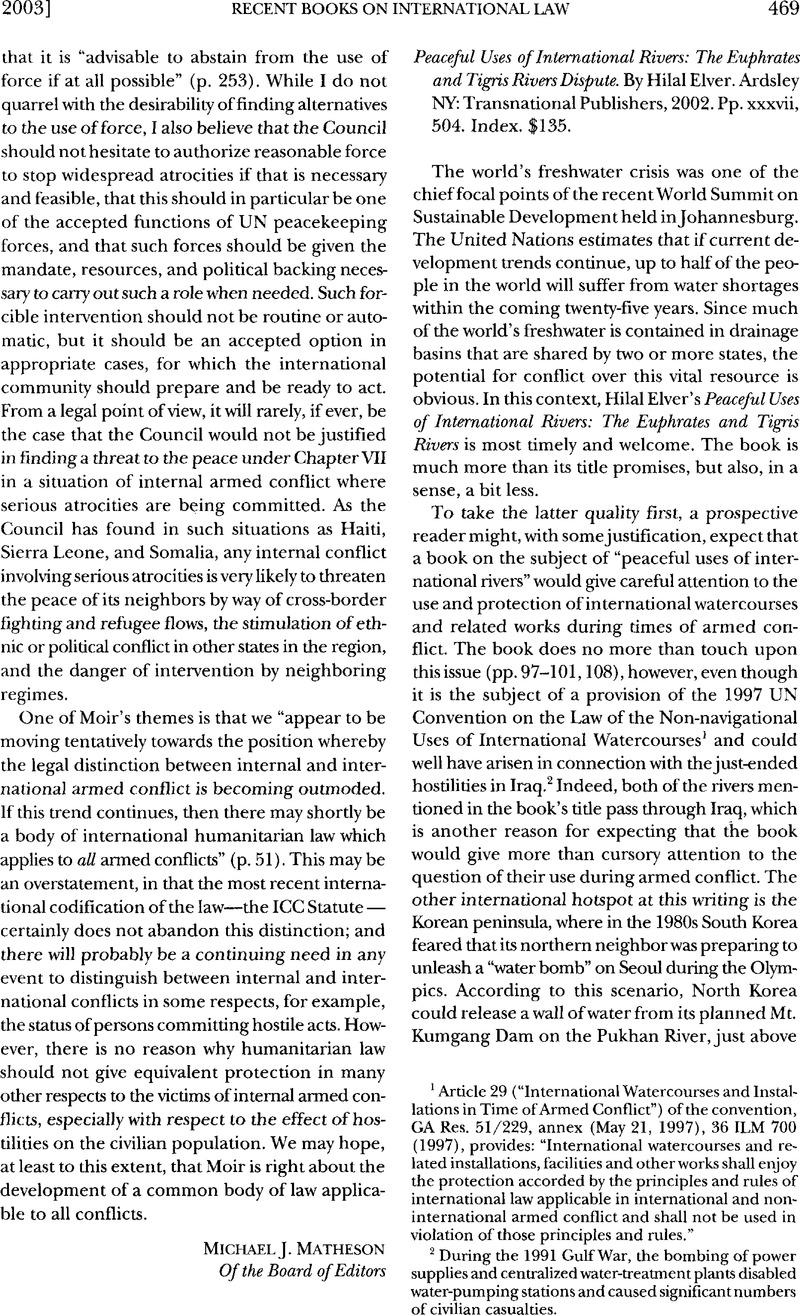Article contents
Peaceful Uses of International Rivers: The Euphrates and Tigris Rivers Dispute. By Hilal Elver. Ardsley NY: Transnational Publishers, 2002. Pp. xxxvii, 504. Index. $135.
Published online by Cambridge University Press: 27 February 2017
Abstract

- Type
- Recent Books on International Law
- Information
- Copyright
- Copyright © American Society of International Law 2003
References
1 Article 29 (“International Watercourses and Installations in Time of Armed Conflict”) of the convention, GA Res. 51/229, annex (May 21, 1997), 36 ILM 700 (1997), provides: “International watercourses and related installations, facilities and other works shall enjoy the protection accorded by the principles and rules of international law applicable in international and non-international armed conflict and shall not be used in violation of those principles and rules.”
2 During the 1991 Gulf War, the bombing of power supplies and centralized water-treatment plants disabled water-pumping stations and caused significant numbers of civilian casualties.
3 The work’s readability is somewhat affected by the evident lack of careful editing and proofreading. One finds different spellings of the same name (for example, Gabcikovo), repeated passages (for example, see p. 244), incorrect dates (for example, 1968 rather than 1969 for the date of the Vienna Convention on the Law of Treaties (p. 231)), frequent failures to provide citations to authority for propositions asserted in the text, and so on.
4 Narmada Bachao Andolan v. Union of India, Writ Petition (C) No. 319 of 1994, judgment, Direction 10, at 91 (Sup. Ct. Oct. 18, 2000) (India) (copy on file with author).
5 Gabčikovo-Nagymaros Project (Hung./Slovk.), 1997 ICJ Rep. 7 (Sept. 25).
6 Lake Lanoux (Fr. v. Spain), 12 R.I.A.A. 281, translated in 24 ILR 101 (1957).
7 The author’s reference here should have been to Czechoslovakia; Slovakia did not become an independent state until January 1, 1993, which was after the events at issue in the case had occurred. For the latter reason, the Court referred throughout its opinion to “Czechoslovakia.” The “summary” of the decision set forth on page 231 likewise should refer to Czechoslovakia, not Slovakia, in relation to the October 1992 diversion of the Danube.
8 Gabčikovo-Nagymaros Project, para. 155.
9 Elver states that this “summary” is “excerpted,” but no citation is given.
10 Gabčikovo-Nagymaros Project, para. 155.
11 Id.
12 See id., para. 18.
13 International Covenant on Economic, Social and Cultural Rights, Dec. 16, 1966, 993 UNTS 3.
14 In 1895, U.S. Attorney General Judson Harmon stated in an opinion that the United States enjoyed “absolute sovereignty” over the waters of the Rio Grande because “the rules, principles, and precedents of international law impose no liability or obligation upon the United States” in respect of Mexico, the downstream state. 21 Op. Att’y Gen. 274, 281–82, 283. Turkey took what was, in effect, this same position by arguing, as indicated, that the Tigris and Euphrates are “ungovernable by international law.”
15 One wonders here whether the author is implicitly referring to some disagreement between Turkey, on the one hand, and Syria and Iraq, on the other, and whether this point of reference is influencing her characterization of the issues.
16 The Bank will thus require an applicant for funding of a project on an international watercourse to notify not only downstream states, but also upstream states, of the planned project; implementing the project might narrow the upstream state’s scope for developing the watercourse in ways that would not unlawfully impair downstream uses.
- 1
- Cited by


